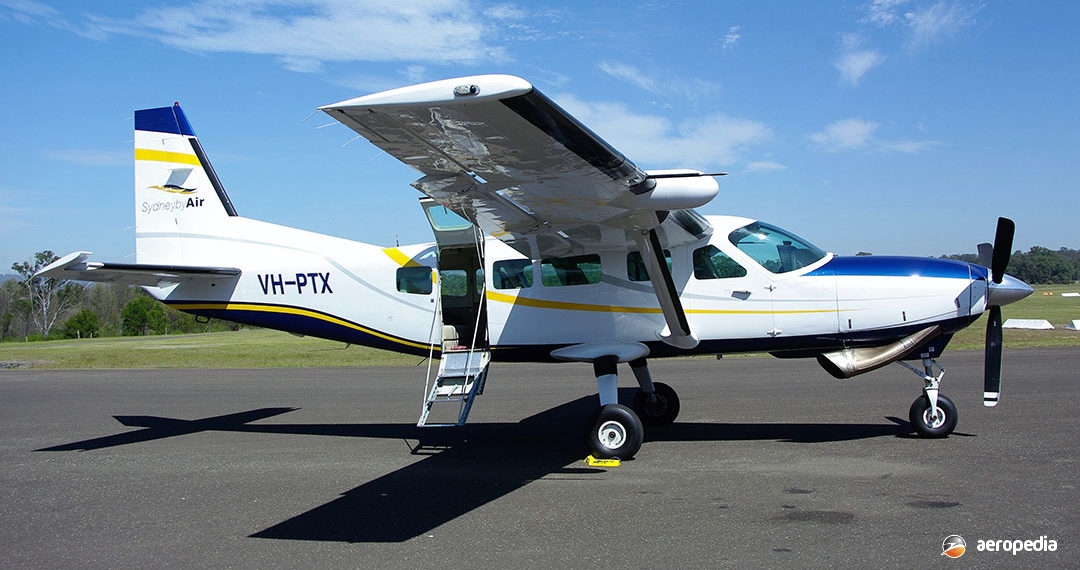Photograph:
Cessna 208 Caravan VH-PTX (c/n 208-00247) at Camden, NSW in November 2011 (David C Eyre)
Country of origin:
United States of America
Description:
Utility transport
Power Plant:
One 448 kw (600 shp) Pratt & Whitney PT6A-114 turboprop
Specifications:
- Wingspan: 15.8 m (51 ft 10 in)
- Length: 11.46 m (37 ft 7 in)
- Height: 4.32 m (14 ft 2 in)
- Wing area: 25.97 m² (279.52 sq ft)
- Max cruising speed at 3,050 m (10,000 ft): 342 km/h (213 mph)
- Max rate of climb at sea level: 367 m/min (1,205 ft/min)
- Stalling speed flaps down: 108 km/h (67 mph)
- Service ceiling: 9,145 m (30,000 ft)
- Range at max cruising speed with max fuel allowances and 45 mins reserve: 1,833 km (1,139 miles)
- Empty weight: 1,682 kg (3,708 lb)
- Loaded weight: 3,311 kg (7,300 lb)
- Max useful load: 1,645 kg (3,627 lb)
History:
The Cessna 208 Caravan I was a completely new utility transport designed by the Cessna Company, and was the largest single-engine aircraft in the Company’s range. Fitted with the tried and proven Pratt & Whitney Canada PT6A turboprop, the type could seat a pilot and up to thirteen passengers at a 79 cm (31 in) pitch. The cabin volume was 9.67 m³ (341.4 cub ft) including a 136 kg (300 lb) luggage area capacity. Four doors were fitted in the fuselage, including a 1.27 m by 1.24 m (50 in by 49 in) cargo door on the portside.
The prototype was flown for the first time on 9 December 1982 and, after certification in October 1984, production aircraft began to be delivered from the assembly line at the Pawnee Aircraft Division facility at Wichita in Kansas.
First of the type seen in this region was a demonstrator N208CC (c/n 00004) which became VH-JEE with Rex Aviation,the Australian distributor. Three were imported for the National Safety Council of Australia (NSCA) whilst that organisation was in operation.
Development of the series has continued. Aero Twin in Alaska has offered a re-engined variant with the de-rated 634 kw (850 shp) Honeywell TPE331-12JR-701S engine driving a four-blade Hartzell propeller; and Soloy had plans to re-engine the Model 208B Grand Caravan with the 634 kw (850 shp) Pratt & Whitney PT6A-42 engine, having previously considered the installation of its Dual Pac twin-PT6 unit but shelved the design.
With final assembly of the type at Wichita in Kansas, since 2003 Cessna has offered new avionics, these including flight-information systems, weather display, terrain and traffic avoidance equipment.
Early production aircraft were fitted with the 448 kw (600 shp) Pratt & Whitney Canada PT6A-114 engine but this was later replaced by the 503 kw (675 shp) PT6A-14A engine, this model becoming known as the Caravan 675.
Certification for the Caravan floatplane was received in March 1986 and the US Government ordered examples under the designation U-27A for military use, these aircraft mainly being supplied to foreign nations under the Foreign Military Sales Program. The U-27A model had increased weights, six underwing hardpoints and a variety of interior options for a variety of roles which have included surveillance and intelligence gathering, reconnaissance, medevac, forward air control and paradropping. However, although some 140 examples have been supplied, most have been standard civil variants with equipment appropriate to the operator’s requirements.
A variant of the Cessna 208 was the AC-208 Combat Caravan, described as a robust day/night intelligence, surveillance and reconnaissance solution available with precision counter insurgency (COIN) capabilities. This variant could be quickly converted to an armed aircraft able to fire Hellfire Missiles, testing of this weapon being carried out in October 2008. Weapons employment and targeting was via an integrated targeting and fire control system and the aircraft had off-board data links which provided full motion video to ground stations and other aircraft. Defensive countermeasure systems and ballistic protection were a standard fitment.
In September 2016 Cessna announced it would be moving its production of the Caravan series from Wichita, Kansas to its facility at Independence, Iowa, where it has been produced alongside the Cessna Models 172, 182, 206 and others. The type has continued in production at the Company’s facility at Independence.
More than 120 examples have been registered in this region, including a number of examples fitted with amphibious floats used in the tourist industry. The type has been very popular in Australia in the skydiving role. A company in Queensland has experimentally installed an electric engine in a Caravan.
A few have been registered in New Zealand, operators including Soundsair at Picton and Air Safaris & Services at Lake Tekapo.
In 2019 a Caravan was fitted with a magniX electric motor, making its first flight over Moses Lake, Washington, US on Wednesday, 29 May 2020.
By early 2020 more than 2,600 Caravans had been delivered to operators in more than 100 countries.

